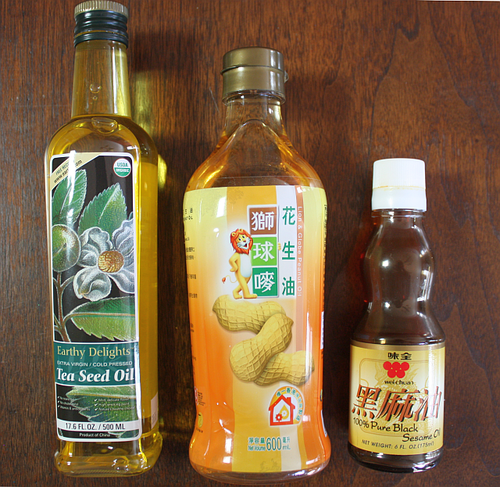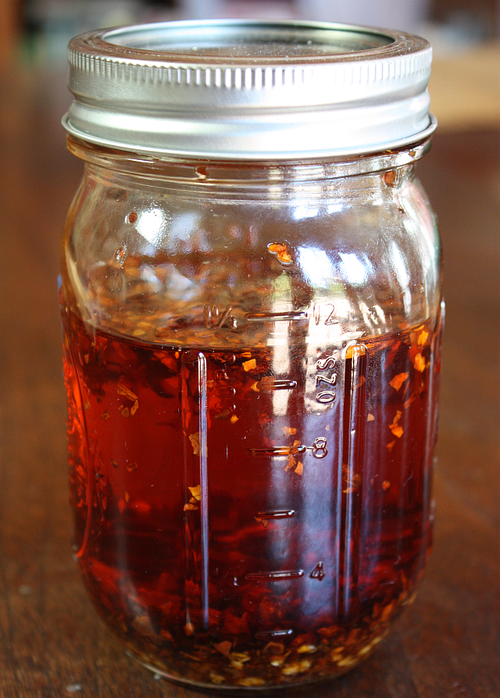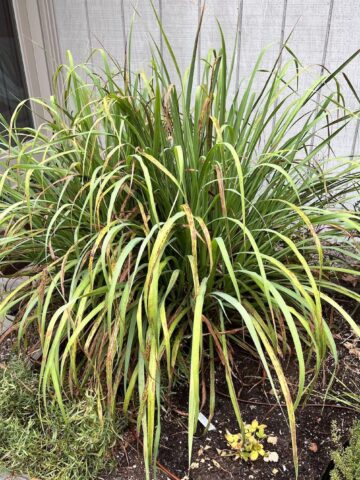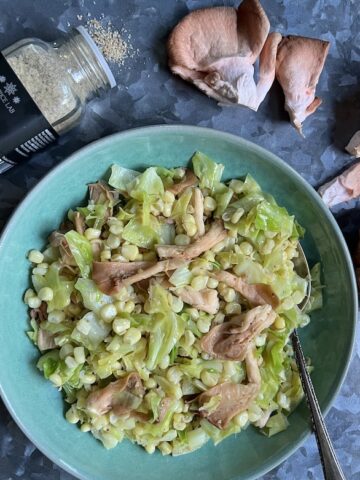Many times when I write recipes, I call for canola oil and
other neutral-flavored oils like grape seed because I want the other ingredient
to shine. But there are situations when you want a flavor-forward oil to
partner with other elements of a dish. That’s the case when you’re making
simple foods that combine a minimal number of ingredients, say a stir-fry of
snow peas and garlic, or when the oil is used as a finishing oil to add a final rich lick and tantalizing
perfume.
So along with the neutrals, I have three flavorful Asian cooking
in my pantry. I wrote about semi-refined
peanut oil last year when we discussed our go-to
cooking oils, and just want to reiterate that it’s damn good oil! The brand
I buy at Asian markets in California is Lion and Globe’s pure peanut oil. It’s somewhat
pricey – about $5 for the small bottle but it’s my secret to making fabulous
tasting Chinese-style chile oil.
The chile oil recipe is in Asian Dumplings and Asian
Tofu. I use it all the time for dipping sauces, seasoning sauces, and as a
homemade finishing oil (use the chile flakes and the oil). Commercially made
chile oil is lackluster and frankly a waste of money for what you get in a
single bottle. Make at batch at home and keep it around for months! Semi-refined
peanut oil lends a wonderful nuttiness to compliment the toastiness of the
chile flakes.
Your food will sing with good chile oil. When Charlotte Druckman made
the spicy yuba skin recipe from Asian
Tofu for her tofu skin story in the Wall
Street Journal, she deliberated about using store bought chile oil as a
convenience. In the end, she tucked my chile oil into her story because “it
makes such a huge difference” in the final dish. I couldn’t agree with her
more. If you want to add one Asian cooking oil to your larder, go with the
peanut. And, Planter’s is not the same.
If you love regular toasted sesame oil, then try black sesame oil sold at Chinese markets.
Yes, the color is darker and so is the flavor, which is slightly bitter on the
tongue and earthier than regular toasted sesame oil. At first, I didn’t like
black sesame oil because it seemed overwhelming. I kept the bottle around and got
to appreciate it over time.
Nowadays, when I want a slightly stronger sesame hit than
usual, I use the black sesame oil, backing off a bit because it packs a punch. You
can cook with sesame oil (try frying Japanese gyoza dumplings!) or drizzle it
onto a plate of fresh-from-the wok kimchi fried rice. Swoon.
Tea seed oil is a
bit harder to find than semi-refined peanut or black sesame oil. I buy mine
online and it’s got the most interesting, nutty-asparagus like flavor. It’s
delicateness shines with simple dishes.
When the oil hits the pan, I like to stick my head over it
to inhale the fragrance. There are times when I say, “Wow, I’m getting extra
wok goodness with tea seed oil.” I’m sure award-wining author and wok expert Grace Young
has an opinion on this.
Tea seed oil is rarely mentioned in Asian cookbooks but it’s
a legit Asian cooking oil. I’ve only seen it in Fuchsia Dunlop’s Hunan cookbook and
a few sites from Asia mention it. Don’t go looking for tea oil that comes from
the Melaleuca
plant that’s used for medicinal purposes. Tea seed oil made from a type
of Camelia. The tea leaves we drink come from a Camelia. Tea seed oil is sometimes marketed as "stir-frying oil."
Tea seed oil is a subtle oil that seems to really come alive
when it’s heated. If you taste it cold, it will seems relatively bland. The Earthy
Delights version of tea seed oil has better flavor than say, Republic of Tea,
which even the representative I met deterred me from tasting his oil.
I’ve read online that tea seed oil is great for your hair
too, keeps it healthy and dark. Maybe I’m onto something by standing over the
hot pan while cooking with tea seed oil?
Next time you venture to a Chinese market or thinking of trying
new cooking oils, check these out. They’re great to keep around for pumping up
flavor and mixing things up a bit.
If you’ve experienced
these oil, what are your thoughts?



















Maggie says
I like to dress steamed Chinese greens with sesame oil. I use a mild and light olive oil for the rare occasions when I fry, or for drizzling over steamed fish.
FreeRangeNan says
Japanese tsubaki (camellia) oil is a specialty item from Oshima, a small island famous for tsubaki. It's not far from Tokyo, off the coast of Izu. The oil is used for both cooking and cosmetic purposes. Supposed to be good for hair & skin. Might be similar to tea seed oil.
Chris says
Rice bran oil isgetting popular too, just for day-to-day cooking. Have tried to start using coconut oil which works well for making curry. And just discovered black sesame seed oil....love it and so worth the extra cost!
Andrea Nguyen says
Nice touch, Maggie!
Andrea Nguyen says
I think it's the same stuff! Great information on the pan-Asian uses. Thank you.
Andrea Nguyen says
I have a bottle of rice bran oil. Someone said it disappeared for a while but is now back. And that jar of coconut oil lingers in my pantry....
jorgebob28 says
Lion and Globe is an excellent brand. My Mom's family used to make their own tsubaki oil in the old days when she was young. Being farmers, you didn't buy that sort of stuff. They made their own sea salt, too.